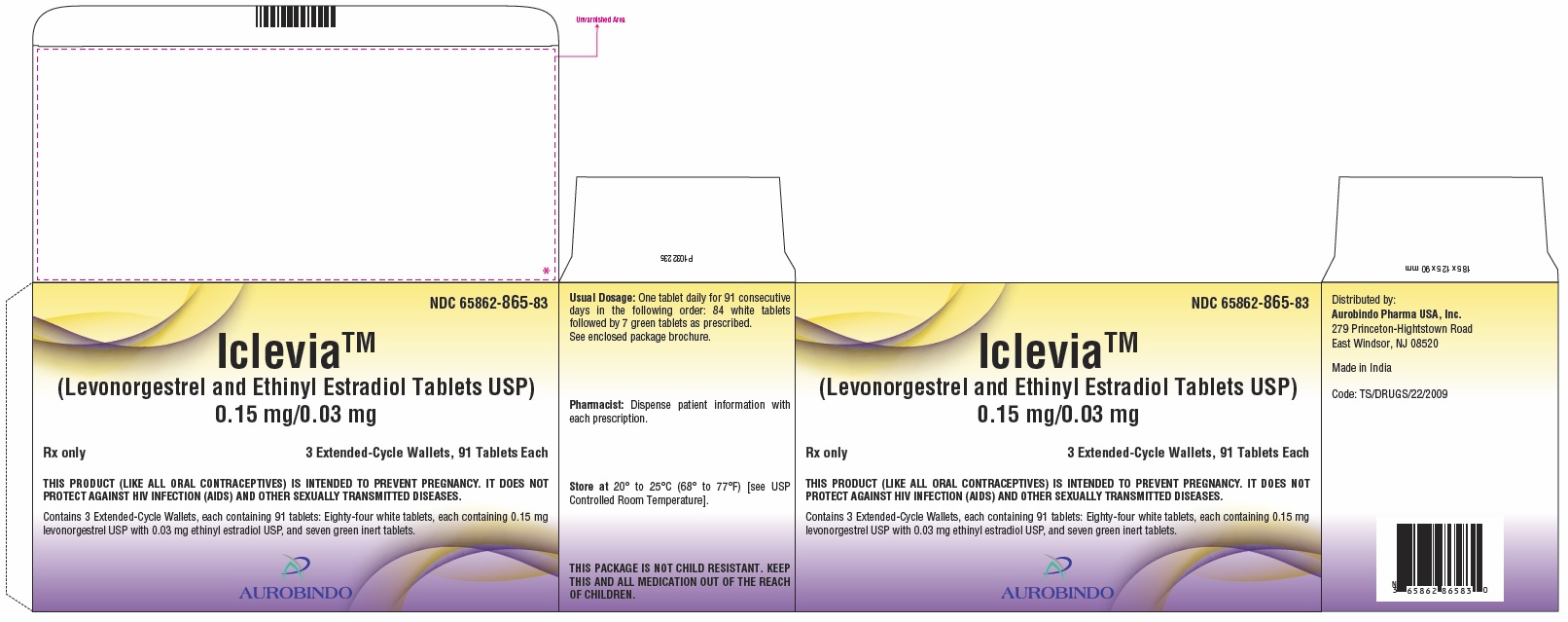FULL PRESCRIBING INFORMATION
WARNING: CIGARETTE SMOKING AND SERIOUS CARDIOVASCULAR EVENTS
Cigarette smoking increases the risk of serious cardiovascular events from combination oral contraceptive (COC) use. This risk increases with age, particularly in women over 35 years of age, and with the number of cigarettes smoked. For this reason, COCs, including Iclevia, are contraindicated in women who are over 35 years of age and smoke [see Contraindications (4) and Warnings and Precautions (5.1)].
1 INDICATIONS AND USAGE
IcleviaTM (levonorgestrel and ethinyl estradiol tablets) is indicated for use by females of reproductive potential to prevent pregnancy.
2 DOSAGE AND ADMINISTRATION
2.1 How to Start and Take Iclevia
Iclevia is dispensed in an Extended-Cycle Wallet [see How Supplied/Storage and Handling (16)]. Iclevia should be started on a Sunday (see Table 1). For the first cycle of a Sunday Start regimen, an additional method of contraception should be used until after the first 7 consecutive days of administration.
Table 1: Instructions for Administration of Iclevia
| Starting Iclevia in females with no current use of hormonal contraception (Sunday Start)
Important: Consider the possibility of ovulation and conception prior to initiation of this product. Tablet Color:
| Sunday Start:
For each 91-day course, take in the following order:
|
| Switching from another contraceptive method to Iclevia
| Start Iclevia:
|
| Another oral contraceptive
| On the day when the new pack of the previous COC would have been started |
| Transdermal patch
| On the day when the next application would have been scheduled. |
| Vaginal ring
| On the day when the next insertion would have been scheduled. |
| Injection
| On the day when the next injection would have been scheduled. |
| Intrauterine contraceptive (IUD)
|
|
| Implant
| On the day of removal. |
Starting Iclevia after Abortion or Miscarriage
First-trimester
- After a first-trimester abortion or miscarriage, Iclevia may be started immediately. An additional method of contraception is not needed if Iclevia is started immediately.
- If Iclevia is not started within 5 days after termination of the pregnancy, the patient should use additional non-hormonal contraception (such as condoms or spermicide) for the first seven days of her first 91-day course of Iclevia.
Second-trimester
- Do not start Iclevia until 4 weeks after a second-trimester abortion or miscarriage, due to the increased risk of thromboembolic disease. Start Iclevia following the instructions in Table 1 for Sunday start. Use additional non-hormonal contraception (such as condoms or spermicide) for the first seven days of the patient’s first 91-day course of Iclevia [see Contraindications (4), Warnings and Precautions (5.1)].
Starting Iclevia after Childbirth
- Do not start Iclevia until 4 weeks after delivery, due to the increased risk of thromboembolic disease. Start contraceptive therapy with Iclevia following the instructions in Table 1 for women not currently using hormonal contraception.
- Iclevia is not recommended for use in lactating women [see Use in Specific Populations (8.2)].
- If the woman has not yet had a period postpartum, consider the possibility of ovulation and conception occurring prior to use of Iclevia [see Contraindications (4), Warnings and Precautions (5.1), Use in Specific Populations (8.1 and 8.2)].
2.2 Dosing Iclevia
Instruct patients to take one tablet by mouth at the same time every day. The dosing of Iclevia is one white pill containing levonorgestrel and ethinyl estradiol daily for 84 consecutive days, followed by one green pill (inactive pills without hormone) for 7 days. To achieve maximum contraceptive effectiveness, Iclevia must be taken exactly as directed, in the order directed on the Wallet, and at intervals not exceeding 24 hours. Start taking the first white pill from a new Wallet the very next day after taking the last green inactive pill in the Wallet. The failure rate may increase when pills are missed or taken incorrectly.
2.3 Missed Doses
Table 2: Instructions for Missed Iclevia Tablets
| Take the tablet as soon as possible. Take the next tablet at the regular time and continue taking one tablet a day until the 91-day course is finished. |
| Take 2 tablets on the day remembered and 2 tablets the next day. Then continue taking one tablet a day until the 91-day course is finished. Additional non-hormonal contraception (such as condoms or spermicide) should be used as back-up if the patient has sex within 7 days after missing tablets. |
| Do not take the missed tablets. Continue taking one tablet a day until the 91-day course is finished. Additional non-hormonal contraception (such as condoms or spermicide) must be used as back-up if the patient has sex within 7 days after missing tablets. |
| Throw away the missed tablets. Continue taking the remaining tablets until the pack is finished. A backup birth control method is not needed. |
3 DOSAGE FORMS AND STRENGTHS
Iclevia (levonorgestrel and ethinyl estradiol tablets USP) are available in Extended-Cycle Wallets, each containing a 13-week supply of tablets in the following order:
- 84 white tablets, each containing 0.15 mg of levonorgestrel and 0.03 mg ethinyl estradiol; round, biconvex, beveled-edge tablets debossed with “S” on one side and “27” on other side.
- 7 green inert tablets; round, mottled, biconvex, beveled-edge uncoated tablets, debossed with “S” on one side and “61” on other side of the tablet.
4 CONTRAINDICATIONS
Iclevia is contraindicated in females who are known to have or develop the following conditions:
- A high risk of arterial or venous thrombotic diseases. Examples include females who are known to:
- Smoke, if over age 35 [see Boxed Warning and Warnings and Precautions (5.1)].
- Have current or history of deep vein thrombosis or pulmonary embolism [see Warnings and Precautions (5.1)].
- Have cerebrovascular disease [see Warnings and Precautions (5.1)].
- Have coronary artery disease [see Warnings and Precautions (5.1)].
- Have thrombogenic valvular or thrombogenic rhythm diseases of the heart (for example, subacute bacterial endocarditis with valvular disease, or atrial fibrillation) [see Warnings and Precautions (5.1)].
- Have inherited or acquired hypercoagulopathies [see Warnings and Precautions (5.1)].
- Have uncontrolled hypertension or hypertension with vascular disease [see Warnings and Precautions (5.4)].
- Have diabetes mellitus and are over age of 35, diabetes mellitus with hypertension or vascular disease or other end-organ damage, or diabetes mellitus of >20 years duration [see Warnings and Precautions (5.7)].
- Have headaches with focal neurological symptoms, migraine headaches with aura, or over age 35 with any migraine headaches [see Warnings and Precautions (5.8)].
- Current diagnosis of, or history of breast cancer, which may be hormone sensitive [see Warnings and Precautions (5.11)].
- Liver tumors, acute viral hepatitis, or severe (decompensated) cirrhosis [see Warnings and Precautions (5.2) and Use in Specific Populations (8.6)].
- Undiagnosed abnormal uterine bleeding [see Warnings and Precautions (5.9)].
- Use of Hepatitis C drug combinations containing ombitasvir/paritaprevir/ritonavir, with or without dasabuvir, due to the potential for ALT elevations [see Warnings and Precautions (5.3)].
5 WARNINGS AND PRECAUTIONS
5.1 Thromboembolic Disorders and Other Vascular Conditions
- Stop Iclevia if an arterial or venous thrombotic/thromboembolic event occurs.
- Stop Iclevia if there is unexplained loss of vision, proptosis, diplopia, papilledema, or retinal vascular lesions. Evaluate for retinal vein thrombosis immediately.
- Discontinue Iclevia during prolonged immobilization. If feasible, stop Iclevia at least 4 weeks before and through 2 weeks after major surgery or other surgeries known to have an elevated risk of thromboembolism.
- Start Iclevia no earlier than 4 weeks after delivery in females who are not breastfeeding. The risk of postpartum thromboembolism decreases after the third postpartum week, whereas the likelihood of ovulation increases after the third postpartum week.
- Before starting Iclevia evaluate any past medical history or family history of thrombotic or thromboembolic disorders and consider whether the history suggests an inherited or acquired hypercoagulopathy. Iclevia is contraindicated in females with a high risk of arterial or venous thrombotic/thromboembolic diseases [see Contraindications (4)].
Arterial Events
COCs increase the risk of cardiovascular events and cerebrovascular events, such as myocardial infarction and stroke. The risk is greater among older women (> 35 years of age), smokers, and females with hypertension, dyslipidemia, diabetes, or obesity.
Iclevia is contraindicated in women over 35 years of age who smoke [see Contraindications (4)]. Cigarette smoking increases the risk of serious cardiovascular events from COC use. This risk increases with age, particularly in women over 35 years of age, and with the number of cigarettes smoked.
Venous Events
Use of COCs increases the risk of venous thromboembolic events (VTEs), such as deep vein thrombosis and pulmonary embolism. Risk factors for VTEs include smoking, obesity, and family history of VTE, in addition to other factors that contraindicate use of COCs [see Contraindications (4)]. While the increased risk of VTE associated with use of COCs is well-established, the rates of VTE are even greater during pregnancy, and especially during the postpartum period (see Figure 1). The rate of VTE in females using COCs has been estimated to be 3 to 9 cases per 10,000 woman years.
The risk of VTE is highest during the first year of use of a COC and when restarting hormonal contraception after a break of four weeks or longer. The risk of thromboembolic disease due to COCs gradually disappears after COC use is discontinued.
Figure 1 shows the risk of developing a VTE for females who are not pregnant and do not use oral contraceptives, for females who use oral contraceptives, for pregnant females and for females in the postpartum period. To put the risk of developing a VTE into perspective: If 10,000 females who are not pregnant and do not use oral contraceptives are followed for one year, between 1 and 5 of these females will develop a VTE.
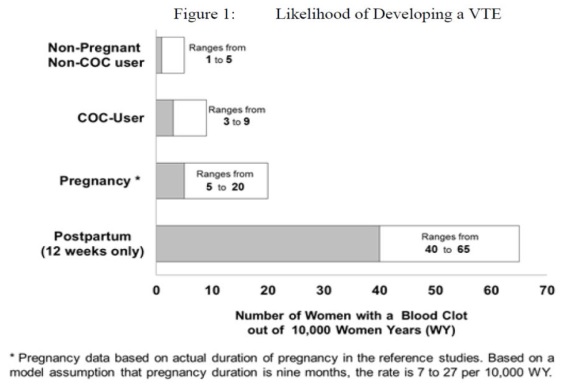
Use of Iclevia provides women with more hormonal exposure on a yearly basis than conventional monthly COCs containing the same strength synthetic estrogens and progestins (an additional 9 weeks of exposure per year). In the clinical trial, one case of pulmonary embolism was reported. Postmarketing adverse reactions of VTE have been reported in women who used Iclevia.
5.2 Liver Disease
Elevated Liver Enzymes
Iclevia is contraindicated in females with acute viral hepatitis or severe (decompensated) cirrhosis of the liver [see Contraindications (4)]. Acute liver test abnormalities may necessitate the discontinuation of Iclevia until the liver tests return to normal and Iclevia causation has been excluded. Discontinue Iclevia if jaundice develops.
Liver Tumors
Iclevia is contraindicated in females with benign and malignant liver tumors [see Contraindications (4)]. COCs increase the risk of hepatic adenomas. An estimate of the attributable risk is 3.3 cases/100,000 COC users. Rupture of hepatic adenomas may cause death through intra-abdominal hemorrhage.
Studies have shown an increased risk of developing hepatocellular carcinoma in long-term (>8 years) COC users. The attributable risk of liver cancers in COC users is less than one case per million users.
5.3 Risk of Liver Enzyme Elevations with Concomitant Hepatitis C Treatment
During clinical trials with the Hepatitis C combination drug regimen that contains ombitasvir/paritaprevir/ritonavir, with or without dasabuvir, ALT elevations greater than 5 times the upper limit of normal (ULN), including some cases greater than 20 times the ULN, were significantly more frequent in women using ethinyl estradiol-containing medications, such as Iclevia. Discontinue Iclevia prior to starting therapy with the combination drug regimen ombitasvir/paritaprevir/ritonavir, with or without dasabuvir [see Contraindications (4)]. Iclevia can be restarted approximately 2 weeks following completion of treatment with the Hepatitis C combination drug regimen.
5.4 Hypertension
Iclevia is contraindicated in females with uncontrolled hypertension or hypertension with vascular disease [see Contraindications (4)]. For all women, including those with well-controlled hypertension, monitor blood pressure at routine visits and stop Iclevia if blood pressure rises significantly.
An increase in blood pressure has been reported in females taking COCs, and this increase is more likely in older women and with extended duration of use. The effect of COCs on blood pressure may vary according to the progestin in the COC.
5.5 Age-related Considerations
The risk for cardiovascular disease and prevalence of risk factors for cardiovascular disease increase with age. Certain conditions, such as smoking and migraine headache without aura, that do not contraindicate COC use in younger females, are contraindications to use in women over 35 years of age [see Contraindications (4) and Warnings and Precautions (5.1)]. Consider the presence of underlying risk factors that may increase the risk of cardiovascular disease or VTE, particularly before initiating Iclevia for women over 35 years, such as:
- Hypertension
- Diabetes
- Dyslipidemia
- Obesity
5.6 Gallbladder Disease
Studies suggest a small increased relative risk of developing gallbladder disease among COC users. Use of COCs, including Iclevia, may worsen existing gallbladder disease.
A past history of COC-related cholestasis predicts an increased risk with subsequent COC use. Females with a history of pregnancy-related cholestasis may be at an increased risk for COC-related cholestasis.
5.7 Adverse Carbohydrate and Lipid Metabolic Effects
Hyperglycemia
Iclevia is contraindicated in diabetic women over age 35, or females who have diabetes with hypertension, nephropathy, retinopathy, neuropathy, other vascular disease or females with diabetes of >20 years of duration [see Contraindications (4)]. Iclevia may decrease glucose tolerance. Carefully monitor prediabetic and diabetic females who are using Iclevia.
Dyslipidemia
Consider alternative contraception for females with uncontrolled dyslipidemia. Iclevia may cause adverse lipid changes.
Females with hypertriglyceridemia, or a family history thereof, may have an increase in serum triglyceride concentrations when using Iclevia, which may increase the risk of pancreatitis.
5.8 Headache
Iclevia is contraindicated in females who have headaches with focal neurological symptoms or have migraine headaches with aura, and in women over age 35 years who have migraine headaches with or without aura [see Contraindications (4)].
If a female taking Iclevia develops new headaches that are recurrent, persistent, or severe, evaluate the cause and discontinue Iclevia if indicated. Consider discontinuation of Iclevia if there is an increased frequency or severity of migraine during COC use (which may be prodromal of a cerebrovascular event) [see Contraindications (4)].
5.9 Bleeding Irregularities and Amenorrhea
Bleeding and/or spotting that occurs at any time while taking the first 84 tablets of each extended-cycle regimen is considered “unscheduled” bleeding/spotting. Bleeding that occurs during the time a woman takes the seven green inert tablets is considered “scheduled” bleeding.
Unscheduled Bleeding and Spotting
Females using Iclevia may experience unscheduled (breakthrough or intracyclic) bleeding and spotting especially during the first 3 months of use. Bleeding irregularities may resolve over time or by changing to a different contraceptive product. If unscheduled bleeding persists or occurs after previously regular cycles, evaluate for causes such as pregnancy or malignancy.
Before prescribing Iclevia, advise the woman to weigh the occurrence of fewer scheduled menses (4 per year instead of 13 per year) against the occurrence of increased unscheduled bleeding and/or spotting.
The clinical trial of the efficacy of Iclevia (91-day cycles) in preventing pregnancy also assessed scheduled and unscheduled bleeding. The participants in the study were composed primarily of women who had used oral contraceptives previously as opposed to new users. Women with a history of breakthrough bleeding/spotting ≥ 10 consecutive days on oral contraceptives were excluded from the study. More Iclevia subjects, compared to subjects on the comparator 28-day cycle regimen, discontinued prematurely for unacceptable bleeding (7.7% [Iclevia] vs. 1.8% [28-day cycle regimen]).
Unscheduled bleeding and unscheduled spotting decreased over successive 91-day cycles. Table 3 below presents the number of days with unscheduled bleeding and/or spotting for each respective 91-day cycle.
| Q1=Quartile 1: 25% of women had ≤ this number of days of unscheduled bleeding/spotting Median: 50% of women had ≤ this number of days of unscheduled bleeding/spotting Q3=Quartile 3: 75% of women had ≤ this number of days of unscheduled bleeding/spotting |
|||||
| Cycle (N)
| Days of Unscheduled Bleeding and/or Spotting per
84-Day Interval | Median Days Per Subject-Month
|
|||
| Mean
| Q1
| Median
| Q3
| ||
| 1 (446) | 15.1 | 3.0 | 12 | 23.0 | 3.0 |
| 2 (368) | 11.6 | 2.0 | 6 | 17.5 | 1.5 |
| 3 (309) | 10.6 | 1.0 | 6 | 15.0 | 1.5 |
| 4 (282) | 8.8 | 1.0 | 4 | 14.0 | 1.0 |
Table 4 shows the percentages of women with ≥7 days and ≥20 days of unscheduled spotting and/or bleeding in the Iclevia and the 28-day cycle treatment groups.
| Days of unscheduled bleeding and/or spotting
| Percentage of Subjectsa
|
|
|---|---|---|
| a Based on spotting and/or bleeding on days 1 to 84 of a 91 day cycle in the Iclevia subjects and days 1 to 21 of a 28 day cycle over 4 cycles in the 28-day dosing regimen. | ||
| Iclevia
| Cycle 1 (N=385) | Cycle 4 (N=261) |
| ≥ 7 days | 65% | 42% |
| ≥ 20 days | 35% | 15% |
| 28-day regimen
| Cycles 1 to 4 (N=194) | Cycles 10 to 13 (N=158) |
| ≥ 7 days | 38% | 39% |
| ≥ 20 days | 6% | 4% |
Total days of bleeding and/or spotting (scheduled plus unscheduled) were similar over one year of treatment for Iclevia subjects and subjects on the 28-day cycle regimen.
Amenorrhea and Oligomenorrhea
Females who use Iclevia may experience absence of scheduled (withdrawal) bleeding, even if they are not pregnant. Based on data from the clinical trial of Iclevia, amenorrhea occurred in approximately 0.8% of females during Cycle 1, 1.2% of females during Cycle 2, 3.7% of females during Cycle 3, and 3.4% of females during Cycle 4.
Because females using Iclevia will likely have scheduled bleeding only 4 times per year, rule out pregnancy at the time of any missed menstrual period.
After discontinuation of Iclevia, amenorrhea or oligomenorrhea may occur, especially if these conditions were pre-existent.
5.10 Depression
Carefully observe females with a history of depression and discontinue Iclevia if depression recurs to a serious degree. Data on the association of COCs with onset of depression or exacerbation of existing depression are limited.
5.11 Malignant Neoplasms
Breast Cancer
Iclevia is contraindicated in females who currently have or have had breast cancer because breast cancer may be hormonally sensitive [see Contraindications (4)].
Epidemiology studies have not found a consistent association between use of combined oral contraceptives (COCs) and breast cancer risk. Studies do not show an association between ever (current or past) use of COCs and risk of breast cancer. However, some studies report a small increase in the risk of breast cancer among current or recent users (<6 months since last use) and current users with longer duration of COC use [see Postmarketing Experience (6.2)].
Cervical Cancer
Some studies suggest that COC are associated with an increase in the risk of cervical cancer or intraepithelial neoplasia. However, there is controversy about the extent to which such findings may be due to differences in sexual behavior and other factors.
5.12 Effect on Binding Globulins
The estrogen component of Iclevia may raise the serum concentrations of thyroxine-binding globulin, sex hormone-binding globulin and cortisol-binding globulin. The dose of replacement thyroid hormone or cortisol therapy may need to be increased.
6 ADVERSE REACTIONS
The following serious adverse reactions with the use of COCs are discussed elsewhere in the labeling:
- Serious cardiovascular events and stroke [see Boxed Warning and Warnings and Precautions (5.1)]
- Vascular events [see Warnings and Precautions (5.1)]
- Liver disease [see Warnings and Precautions (5.2)]
6.1 Clinical Trial Experience
Because clinical trials are conducted under widely varying conditions, adverse reaction rates observed in the clinical trials of a drug cannot be directly compared to the rates in the clinical trials of another drug and may not reflect the rates observed in clinical practice.
The clinical trial that evaluated the safety and efficacy of Iclevia was a 12-month, randomized, multicenter, open-label study, which enrolled women aged 18 to 40, of whom 456 took at least one dose of Iclevia (345.14 woman-years of exposure) [see Clinical Studies (14)].
Adverse Reactions Leading to Study Discontinuation: 14.9% of the women discontinued from the clinical trial due to an adverse reaction; the most common adverse reactions (≥ 1% of women) leading to discontinuation in the Iclevia group were menorrhagia (5.7%), mood swings (1.9%), weight/appetite increase (1.5%), and acne (1.3%).
Common Adverse Reactions (≥ 2% of women): headache (20.6%), menorrhagia (11.6%), nausea (7.5%), dysmenorrhea (5.7%), acne (4.6%), migraine (4.4%), breast tenderness (3.5%), weight increased (3.1%), and depression (2.1%).
Serious Adverse Reactions: pulmonary embolus, cholecystitis.
6.2 Postmarketing Experience
Five studies that compared breast cancer risk between ever-users (current or past use) of COCs and never-users of COCs reported no association between ever use of COCs and breast cancer risk, with effect estimates ranging from 0.90 to 1.12 (Figure 2).
Three studies compared breast cancer risk between current or recent COC users (<6 months since last use) and never users of COCs (Figure 2). One of these studies reported no association between breast cancer risk and COC use. The other two studies found an increased relative risk of 1.19 to 1.33 with current or recent use. Both of these studies found an increased risk of breast cancer with current use of longer duration, with relative risks ranging from 1.03 with less than one year of COC use to approximately 1.4 with more than 8 to 10 years of COC use.
Figure 2: Relevant Studies of Risk of Breast Cancer with Combined Oral Contraceptives
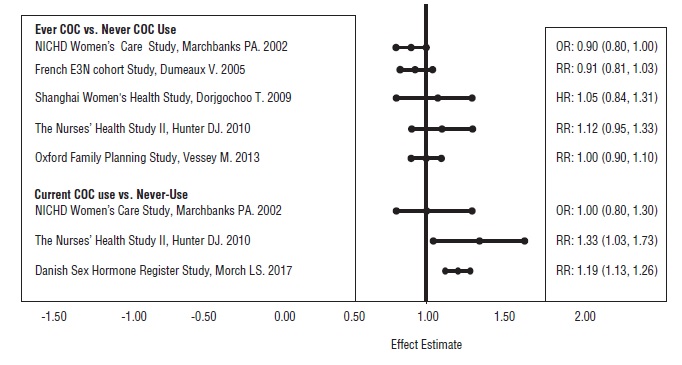
RR = relative risk; OR = odds ratio; HR = hazard ratio. “ever COC” are females with current or past COC use; “never COC use” are females that never used COCs.
The following adverse reactions have been identified during post-approval use of Iclevia. Because these reactions are reported voluntarily from a population of uncertain size, it is not possible to reliably estimate their frequency or establish a causal relationship to drug exposure.
Gastrointestinal disorders: abdominal distension, vomiting
General disorders and administration site conditions: chest pain, fatigue, malaise, edema peripheral, pain
Immune system disorder: hypersensitivity reactions, including itching, rash, and angioedema
Investigations: blood pressure increased
Musculoskeletal and connective tissue disorders: muscle spasms, pain in extremity
Nervous system disorders: dizziness, loss of consciousness
Psychiatric disorders: insomnia
Reproductive and breast disorders: dysmenorrhea
Skin and subcutaneous tissue disorders: alopecia
Vascular disorders: thrombosis, pulmonary embolism, pulmonary thrombosis
7 DRUG INTERACTIONS
The sections below provide information on substances for which data on drug interactions with COCs are available. There is little information available about the clinical effect of most drug interactions that may affect COCs. However, based on the known pharmacokinetic effects of these drugs, clinical strategies to minimize any potential adverse effect on contraceptive effectiveness or safety are suggested.
Consult the approved product labeling of all concurrently used drugs to obtain further information about interactions with COCs or the potential for metabolic enzyme or transporter system alterations.
No drug-drug interaction studies were conducted with Iclevia.
7.1 Effects of Other Drugs on Combined Oral Contraceptives
Substances decreasing the plasma concentrations of COCs and potentially diminishing the efficacy of COCs:
Table 5 includes substances that demonstrated an important drug interaction with Iclevia.
| a Induction potency of St. John’s wort may vary widely based on preparation. | |
| Metabolic Enzyme Inducers |
|
| Clinical effect |
|
| Prevention or management |
|
| Examples | Aprepitant, barbiturates, bosentan, carbamazepine, efavirenz, felbamate, griseofulvin, oxcarbazepine, phenytoin, rifampin, rifabutin, rufinamide, topiramate, products containing St. John’s worta, and certain protease inhibitors (see separate section on protease inhibitors below). |
| Colesevelam
|
|
| Clinical effect |
|
| Prevention or management | Administer 4 or more hours apart to attenuate this drug interaction. |
Substances increasing the systemic exposure of COCs:
Co-administration of atorvastatin or rosuvastatin and certain COCs containing ethinyl estradiol (EE) increase AUC values for EE by approximately 20 to 25%. Ascorbic acid and acetaminophen may increase systemic exposure of EE possibly by inhibition of conjugation. CYP3A4 inhibitors such as itraconazole, voriconazole, fluconazole, grapefruit juice, or ketoconazole may increase systemic exposure of estrogen and/or progestin component of COCs.
Human immunodeficiency virus (HIV)/ Hepatitis C virus (HCV) protease inhibitors and non-nucleoside reverse transcriptase inhibitors:
Significant decreases in systemic exposure of the estrogen and/or progestin have been noted when COCs are co-administered with some HIV protease inhibitors (e.g., nelfinavir, ritonavir, darunavir/ritonavir, (fos)amprenavir/ritonavir, lopinavir/ritonavir, and tipranavir/ritonavir] or some HCV protease inhibitors (e.g. boceprevir and telaprevir) and some non-nucleosidase reverse transcriptase inhibitors (e.g. nevirapine)
In contrast, significant increases in systemic exposure of the estrogen and/or progestin have been noted when COCs are co-administered with certain other HIV protease inhibitors (e.g. indinavir and atazanavir/ritonavir) and with other non-nucleoside reverse transcriptase inhibitors (e.g. etravirine).
7.2 Effects of Combined Oral Contraceptives on Other Drugs
Table 6 provides significant drug interaction information for drugs co-administered with Iclevia.
| Lamotrigine
|
|
| Clinical effect |
|
| Prevention or management | Dose adjustment may be necessary. Consult the approved product labeling for lamotrigine. |
| Thyroid Hormone Replacement Therapy or Corticosteroid Replacement Therapy
|
|
| Clinical effect | Concomitant use of COCs with thyroid hormone replacement therapy or corticosteroid replacement therapy may increase systemic exposure of thyroid-binding and cortisol-binding globulin [see Warnings and Precautions (5.12)]. |
| Prevention or management | The dose of replacement thyroid hormone or cortisol therapy may need to be increased. Consult the approved product labeling for the therapy in use [see Warnings and Precautions (5.12)]. |
| Other Drugs
|
|
| Clinical effect | Concomitant use of COCs may decrease systemic exposure of acetaminophen, morphine, salicylic acid, and temazepam. Concomitant use with ethinyl estradiol-containing COCs may increase systemic exposure of other drugs (e.g., cyclosporine, prednisolone, theophylline, tizanidine, and voriconazole). |
| Prevention or management | The dosage of drugs that can be affected by this interaction may need to be increased. Consult the approved product labeling for the concomitantly used drug. |
7.3 Concomitant Use with Hepatitis C Virus (HCV) Combination Therapy-Liver Enzyme Elevation
Co-administration of Iclevia with HCV drug combinations containing ombitasvir/paritaprevir/ritonavir, with or without dasabuvir is contraindicated due to potential for ALT elevations [see Warning and Precautions (5.3)]. Co-administration of Iclevia and glecaprevir/pibrentasvir is not recommended due to potential for ALT elevations.
8 USE IN SPECIFIC POPULATIONS
8.1 Pregnancy
Risk Summary
There is no use for contraception in pregnancy; therefore, Iclevia should be discontinued during pregnancy. Epidemiologic studies and meta-analyses have not found an increased risk of genital or non-genital birth defects (including cardiac anomalies and limb-reduction defects) following exposure to COCs before conception or during early pregnancy.
In the U.S. general population, the estimated background risk of major birth defects and miscarriage in clinically recognized pregnancies is 2 to 4 percent and 15 to 20 percent, respectively.
8.2 Lactation
Risk Summary
Contraceptive hormones and/or metabolites are present in human milk. COCs can reduce milk production in breastfeeding females. This reduction can occur at any time but is less likely to occur once breastfeeding is well-established. When possible, advise the nursing female to use other methods of contraception until she discontinues breastfeeding [see Dosage and Administration (2.1)]. The developmental and health benefits of breastfeeding should be considered along with the mother’s clinical need for Iclevia and any potential adverse effects on the breastfed child from Iclevia or the underlying maternal condition.
8.4 Pediatric Use
Safety and efficacy of Iclevia have been established in women of reproductive age. Efficacy is expected to be the same for postpubertal adolescents under the age of 18 as for users 18 years and older. Use of Iclevia before menarche is not indicated.
8.5 Geriatric Use
Iclevia has not been studied in postmenopausal women and is not indicated in this population.
8.6 Hepatic Impairment
The pharmacokinetics of Iclevia have not been studied in subjects with hepatic impairment. However, COCs may be poorly metabolized in patients with hepatic impairment. Iclevia is contraindicated in females with acute hepatitis or severe decompensated cirrhosis [see Contraindications (4) and Warnings and Precautions (5.2)].
10 OVERDOSAGE
There have been no reports of serious ill effects from overdose of oral contraceptives, including ingestion by children. Overdosage may cause withdrawal bleeding in females and nausea.
11 DESCRIPTION
Iclevia (levonorgestrel and ethinyl estradiol tablets USP) is an extended-cycle combination oral contraceptive consisting of 84 white active tablets each containing 0.15 mg of levonorgestrel USP, a synthetic progestin and 0.03 mg of ethinyl estradiol USP, an estrogen, and 7 green inert tablets (without hormones).
The structural formulas for the active components are:
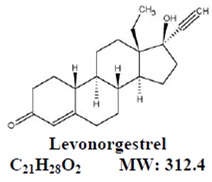
Levonorgestrel is chemically 18,19-Dinorpregn-4-en-20-yn-3-one, 13-ethyl-17-hydroxy-, (17α)-, (-)-.

Ethinyl Estradiol is 19-Norpregna-1,3,5(10)-trien-20-yne-3,17-diol, (17α)-.
- Each white active tablet contains the following inactive ingredients: croscarmellose sodium, lactose monohydrate, magnesium stearate, microcrystalline cellulose, and povidone.
- Each green inert tablet contains the following inactive ingredients: anhydrous lactose, croscarmellose sodium, FD&C Blue No.2 Aluminum Lake, ferric oxide yellow, magnesium stearate, microcrystalline cellulose, and povidone.
12 CLINICAL PHARMACOLOGY
12.3 Pharmacokinetics
Absorption
No specific investigation of the absolute bioavailability of Iclevia in humans has been conducted. However, literature indicates that levonorgestrel is rapidly and completely absorbed after oral administration (bioavailability nearly 100%) and is not subject to first-pass metabolism. EE is rapidly and almost completely absorbed from the gastrointestinal tract but, due to first-pass metabolism in gut mucosa and liver, the bioavailability of EE is approximately 43%.
Following continuous dosing with once-daily administration of Iclevia tablets, plasma concentrations of levonorgestrel and EE reached steady-state within 7 days. The mean plasma pharmacokinetic parameters for Iclevia under fasting conditions in normal healthy women following once-daily administration of one levonorgestrel/EE combination tablet for 10 days are summarized in Table 7.
| Analyte
| AUC0-24
| Cmax
| C min
| Cavga
| Tmax
|
|---|---|---|---|---|---|
| a Cavg = AUC0-24/24 | |||||
| Levonorgestrel | 54.6 ± 16.5 ng*hr/mL | 5.0 ± 1.5 ng/mL | 1.6 ± 0.5 ng/mL | 2.3 ± 0.7 ng/mL | 1.4 ± 0.7 hours |
| Ethinyl estradiol | 935.5 ± 346.9 pg*hr/mL | 106.1 ± 41.2 pg/mL | 18.5 ± 9.4 pg/mL | 38.9 ± 14.4 pg/mL | 1.6 ± 0.6 hours |
Food Effect
The effect of food on the rate and the extent of levonorgestrel and EE absorption following oral administration of Iclevia has not been evaluated.
Distribution
The apparent volume of distribution of levonorgestrel and EE are reported to be approximately 1.8 L/kg and 4.3 L/kg, respectively. Levonorgestrel is about 97.5 to 99% protein-bound, principally to sex hormone binding globulin (SHBG) and, to a lesser extent, serum albumin. EE is about 95 to 97% bound to serum albumin. EE does not bind to SHBG, but induces SHBG synthesis, which leads to decreased levonorgestrel clearance. Following repeated daily dosing of levonorgestrel/EE oral contraceptives, levonorgestrel plasma concentrations accumulate more than predicted based on single-dose pharmacokinetics, due in part, to increased SHBG levels that are induced by EE, and a possible reduction in hepatic metabolic capacity.
Metabolism
Following absorption, levonorgestrel is conjugated at the 17β-OH position to form sulfate and to a lesser extent, glucuronide conjugates in plasma. Significant amounts of conjugated and unconjugated 3α,5β-tetrahydrolevonorgestrel are also present in plasma, along with much smaller amounts of 3α,5α-tetrahydrolevonorgestrel and 16β-hydroxylevonorgestrel. Levonorgestrel and its phase I metabolites are excreted primarily as glucuronide conjugates. Metabolic clearance rates may differ among individuals by several-fold, and this may account in part for the wide variation observed in levonorgestrel concentrations among users.
First-pass metabolism of EE involves formation of EE-3-sulfate in the gut wall, followed by 2-hydroxylation of a portion of the remaining untransformed EE by hepatic cytochrome P-450 3A4 (CYP3A4). Levels of CYP3A4 vary widely among individuals and can explain the variation in rates of EE hydroxylation. Hydroxylation at the 4-, 6-, and 16- positions may also occur, although to a much lesser extent than 2-hydroxylation. The various hydroxylated metabolites are subject to further methylation and/or conjugation.
Excretion
About 45% of levonorgestrel and its metabolites are excreted in the urine and about 32% are excreted in feces, mostly as glucuronide conjugates. The terminal elimination half-life for levonorgestrel after a single dose of Iclevia was about 30 hours.
EE is excreted in the urine and feces as glucuronide and sulfate conjugates, and it undergoes enterohepatic recirculation. The terminal elimination half-life of EE after a single dose of Iclevia was found to be about 15 hours.
14 CLINICAL STUDIES
In a 12-month, multicenter, randomized, open-label clinical trial, 456 women aged 18 to 40 were studied to assess the safety and efficacy of Iclevia, completing 809 91-day cycles of exposure. The racial demographic of those enrolled was: Caucasian (77%), African-American (11%), Hispanic (7%), Asian (2%), and Other (3%). There were no exclusions for body mass index (BMI) or weight. The weight range of those women treated was 84 to 304 pounds, with a mean weight of 157 pounds and a median weight of 147 pounds. Among the women in the trial, 63% were current or recent hormonal contraceptive users, 29% were prior users (who had used hormonal contraceptives in the past but not in the 6 months prior to enrollment), and 8% were new starts.
The pregnancy rate (Pearl Index [PI]) in the 397 women aged 18 to 35 years was 1.98 pregnancies per 100 women-years of use (95% CI: 0.54 to 5.03), based on 4 pregnancies that occurred after the onset of treatment and within 14 days after the last combination pill. Cycles in which conception did not occur, but which included the use of back-up contraception, were not included in the calculation of the PI.
16 HOW SUPPLIED/STORAGE AND HANDLING
How Supplied
Iclevia (levonorgestrel and ethinyl estradiol tablets USP) are available in Extended-Cycle Wallets, each containing a 13-week supply of tablets in the following order:
- 84 white tablets, each containing 0.15 mg of levonorgestrel and 0.03 mg ethinyl estradiol; round, biconvex, beveled-edge tablets debossed with “S” on one side and “27” on other side.
- 7 green inert tablets; round, mottled, biconvex, beveled-edge uncoated tablets, debossed with “S” on one side and “61” on other side of the tablet.
Pouch of 1 Extended-Cycle Wallet NDC 65862- 865-94
Carton of 3 Pouches NDC 65862- 865-83
Storage and Handling
- Store at 20º to 25°C (68° to 77º F) [see USP Controlled Room Temperature].
- Protect from light.
17 PATIENT COUNSELING INFORMATION
Advise the patient to read the FDA-approved patient labeling (Patient Information and Instructions for Use).
Cigarette Smoking
Cigarette smoking increases the risk of serious cardiovascular events from COC use. Women who are over 35 years old and smoke should not use Iclevia [see Boxed Warning and Warnings and Precautions (5.1)].
Venous Thromboembolism
The increased risk of VTE compared to non-users of COCs is greatest after initially starting a COC or restarting (following a 4-week or greater pill-free interval) the same or a different COC [see Warnings and Precautions (5.1)].
Use During Pregnancy
Instruct females to stop further intake of Iclevia if pregnancy is confirmed during treatment.
Sexually Transmitted Infections
Iclevia does not protect against HIV-infection (AIDS) and other sexually transmitted infections.
Dosing and Missed Pill Instructions
- Patients should take one tablet daily by mouth at the same time every day [see Dosage and Administration (2.1)].
- Instruct patients what to do in the event tablets are missed. See “What should I do if I miss any Iclevia pills” section in FDA-approved Instructions for Use [see Dosage and Administration (2.3)].
Need for Additional Contraception
- Postpartum females who start Iclevia who have not yet had a period when they start Iclevia need to use an additional method of contraception until they have taken a white tablet for 7 consecutive days [see Dosage and Administration (2.1)].
- There is a need for a back-up or alternative method of contraception when enzyme inducers are used with Iclevia [see Drug Interactions (7.1)].
Lactation
Iclevia may reduce breast milk production. This is less likely to occur if breastfeeding is well established. When possible, nursing women should use other methods of contraception until they have discontinued breastfeeding [see Use in Specific Populations (8.2)].
Amenorrhea and Possible Symptoms of Pregnancy
Amenorrhea may occur. Because women using Iclevia will likely have scheduled bleeding only 4 times per year, advise women to contact their health care provider in the event of amenorrhea with symptoms of pregnancy such as morning sickness or unusual breast tenderness [see Warnings and Precautions (5.9)].
Depression
Depressed mood and depression may occur. Women should contact their healthcare provider if mood changes and depressive symptoms occur, including shortly after initiating the treatment [see Warnings and Precautions (5.10)].
Distributed by:
Aurobindo Pharma USA, Inc.
279 Princeton-Hightstown Road
East Windsor, NJ 08520
Manufactured by:
Aurobindo Pharma Limited
Hyderabad-500 032, India
Revised: 04/2023
FDA-approved Patient Labeling
Patient Information
IcleviaTM
[eye kle' vee ah]
(levonorgestrel and ethinyl estradiol tablets USP)
| WARNING TO WOMEN WHO SMOKE
Do not use Iclevia if you smoke cigarettes and are over 35 years old. Smoking increases your risk of serious cardiovascular side effects from birth control pills, including death from heart attack, blood clots or stroke. This risk increases with age and the number of cigarettes you smoke. |
What is the most important information I should know about Iclevia?
Do not use Iclevia if you smoke cigarettes and are over 35 years old. Smoking increases your risk of serious cardiovascular side effects from birth control pills, including death from heart attack, blood clots or stroke. This risk increases with age and the number of cigarettes you smoke.
What is Iclevia?
Iclevia is a birth control pill (oral contraceptive) used by women to prevent pregnancy. It contains two female hormones, an estrogen called ethinyl estradiol, and a progestin called levonorgestrel. Iclevia does not protect against HIV infections (AIDS) and other sexually transmitted infections.
How does Iclevia work for contraception?
Your chance of getting pregnant depends on how well you follow the directions for taking your birth control pills. The better you follow the directions, the less chance you have of getting pregnant.
Based on the results of clinical studies, about 1 to 5 out of 100 women may get pregnant during the first year they use Iclevia.
The following chart shows the chance of getting pregnant for women who use different methods of birth control. Each box on the chart contains a list of birth control methods that are similar in effectiveness. The most effective methods are at the top of the chart. The box on the bottom of the chart shows the chance of getting pregnant for women who do not use birth control and are trying to get pregnant.
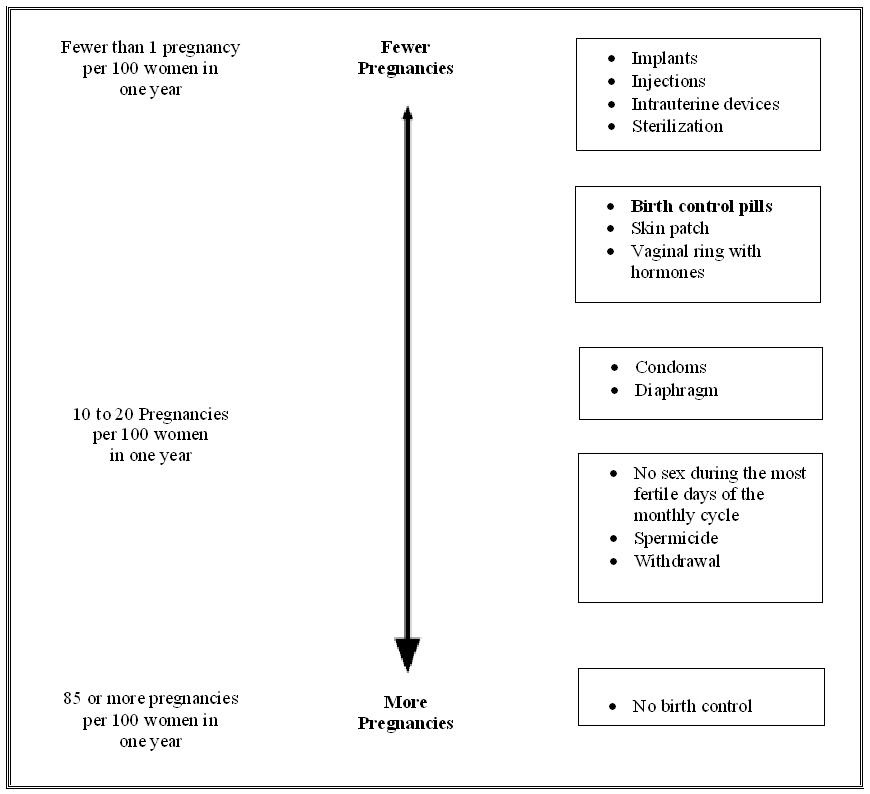
Who should not take Iclevia?
Do not take Iclevia if you:
- smoke and are over 35 years of age
- have or had blood clots in your arms, legs, lungs, or eyes
- had a stroke
- had a heart attack
- have certain heart valve problems or heart rhythm abnormalities that can cause blood clots to form in the heart
- have or had a problem with your blood that makes it clot more than normal
- have high blood pressure that cannot be controlled by medicine or have high blood pressure with blood vessels problems
- have diabetes
- and are over the age of 35
- with high blood pressure
- with kidney, eye, nerve, or blood vessel damage
- for more than 20 years
- have certain kinds of severe migraine headaches with aura, numbness, weakness or changes in vision, or any migraine headaches if you are over 35 years of age
- have or had breast cancer
- have liver problems, including liver tumors
- have any unexplained vaginal bleeding
- take any Hepatitis C drug combination containing ombitasvir/paritaprevir/ritonavir, with or without dasabuvir. This may increase levels of the liver enzyme “alanine aminotransferase” (ALT) in the blood.
If any of these conditions happen to you while you are taking Iclevia, stop taking Iclevia right away and talk to your healthcare provider. Use non-hormonal contraception when you stop taking Iclevia.
What should I tell my healthcare provider before taking Iclevia?
Tell your healthcare provider if you:
- are pregnant or think you may be pregnant
- are scheduled for surgery. Iclevia may increase your risk of blood clots after surgery. You should stop taking Iclevia at least 4 weeks before you have surgery and not restart Iclevia until at least 2 weeks after your surgery.
- are depressed now or have been depressed in the past
- had yellowing of your skin or eyes (jaundice) caused by pregnancy (cholestasis of pregnancy)
- are breastfeeding or plan to breastfeed. Iclevia may decrease the amount of breast milk you make. A small amount of the hormones in Iclevia may pass into your breast milk. Talk to your healthcare provider about the best birth control method for you while breastfeeding.
Tell your healthcare provider if you have ever had any of the conditions listed in, “Who should not take Iclevia” above. Your healthcare provider may recommend another method of birth control.
Tell your healthcare provider about all the medicines you take, including prescription and over-the-counter medicines, vitamins and herbal supplements.
Iclevia may affect the way other medicines work, and other medicines may affect how well Iclevia works.
Some medicines and herbal products may make birth control pills less effective, including:
- barbiturates
- bosentan
- carbamazepine
- felbamate
- griseofulvin
- oxcarbazepine
- phenytoin
- rifampin
- St. John’s wort
- topiramate
Use a back-up or alternative birth control method when you take medicines that may make birth control pills less effective.
Birth control pills may interact with lamotrigine, an anticonvulsant used for epilepsy. This may increase the risk of seizures, so your physician may need to adjust the dose of lamotrigine.
Women on thyroid hormone replacement therapy may need increased doses of thyroid hormone.
Know the medicines you take. Keep a list of them to show your healthcare provider and pharmacist when you get a new medicine.
How should I take Iclevia?
Read the Instructions for Use at the end of this Patient Information.
What are the most serious risks of taking Iclevia?
Like pregnancy, Iclevia may cause serious side effects, including blood clots in your lungs, heart attack, or a stroke that may lead to death. Some other examples of serious blood clots include blood clots in the legs or eyes. Serious blood clots can happen especially if you smoke, are obese, or are older than 35 years of age. Serious blood clots are more likely to happen when you:
- first start taking birth control pills
- restart the same or different birth control pills after not using them for a month or more
Call your healthcare provider or go to a hospital emergency room right away if you have:
- leg pain that will not go away
- sudden severe shortness of breath
- sudden change in vision or blindness
- chest pain
- a sudden, severe headache unlike your usual headaches
- weakness or numbness in your arm or leg
- trouble speaking
- yellowing of your skin or eyes
Other serious side effects include:
-
liver problems, including:
- rare liver tumors
- jaundice (cholestasis), especially if you previously had cholestasis of pregnancy.
- high blood pressure. You should see your healthcare provider to check your blood pressure regularly.
- gallbladder problems
- changes in the sugar and fat (cholesterol and triglycerides) levels in your blood
- new or worsening headaches including migraine headaches
- irregular or unusual vaginal bleeding and spotting between your menstrual periods, especially during the first 3 months of taking Iclevia.
- depression, especially if you have had depression in the past. Call your healthcare provider immediately if you have any thoughts of harming yourself.
- possible cancer in your breast and cervix
- swelling of your skin especially around your mouth, eyes, and in your throat (angioedema). Call your healthcare provider if you have a swollen face, lips, mouth tongue or throat, which may lead to difficulty swallowing or breathing. Your chance of having angioedema is higher is you have a history of angioedema.
- dark patches of skin around your forehead, nose, cheeks and around your mouth, especially during pregnancy (chloasma). Women who tend to get chloasma should avoid spending a long time in sunlight, tanning booths, and under sun lamps while taking Iclevia. Use sunscreen if you have to be in the sunlight.
What are the most common side effects of Iclevia?
- headache (migraine)
- heavier or longer periods, pain with periods
- nausea
- acne
- breast tenderness
- increase in weight
These are not all the possible side effects of Iclevia. For more information, ask your healthcare provider or pharmacist. You may report side effects to the FDA at 1-800-FDA-1088.
What else should I know about taking Iclevia?
- If you are scheduled for any lab tests, tell your healthcare provider you are taking Iclevia. Certain blood tests may be affected by Iclevia.
- Do not skip any pills, even if you do not have sex often.
- Birth control pills should not be taken during pregnancy. However, birth control pills taken by accident during pregnancy are not known to cause birth defects.
- You should stop Iclevia at least four weeks before you have major surgery and not restart it for at least two weeks after the surgery, due to an increased risk of blood clots.
- If you are breastfeeding, consider another birth control method until you are ready to stop breastfeeding. Birth control pills that contain estrogen, like Iclevia, may decrease the amount of milk you make. A small amount of the pill's hormones pass into breast milk, but this has not caused harmful effects in breastfeeding infants.
- If you have vomiting or diarrhea, your birth control pills may not work as well. Use another birth control method, like condoms or a spermicide, until you check with your healthcare provider.
How should I store Iclevia?
- Store Iclevia at room temperature between 20º to 25°C (68° to 77º F). Protect from light.
- Keep Iclevia and all medicines out of the reach of children.
General information about the safe and effective use of Iclevia
Medicines are sometimes prescribed for purposes other than those listed in a Patient Information leaflet. Do not use Iclevia for a condition for which it was not prescribed. Do not give Iclevia to other people, even if they have the same symptoms that you have.
This Patient Information summarizes the most important information about Iclevia. You can ask your pharmacist or healthcare provider for information about Iclevia that is written for health professionals.
For more information, call Aurobindo Pharma USA, Inc. at 1-866-850-2876.
Do birth control pills cause cancer?
It is not known if hormonal birth control pills cause breast cancer. Some studies, but not all, suggest that there could be a slight increase in the risk of breast cancer among current users with longer duration of use.
If you have breast cancer now, or have had it in the past, do not use hormonal birth control because some breast cancers are sensitive to hormones. Women who use birth control pills may have a slightly higher chance of getting cervical cancer. However, this may be due to other reasons such as having more sexual partners.
What if I want to become pregnant?
You may stop taking the pill whenever you wish. Consider a visit with your healthcare provider for a pre-pregnancy checkup before you stop taking the pill.
What should I know about my period when taking Iclevia?
When you take Iclevia, which has a 91-day extended dosing cycle, you should have 4 scheduled periods a year (bleeding when you are taking the 7 green pills). However, you will probably have more bleeding or spotting between your scheduled periods than if you were using a birth control pill with a 28-day dosing cycle. During the first Iclevia 91-day treatment cycle, about 1 in 3 women may have 20 or more days of unplanned bleeding or spotting. This bleeding or spotting tends to decrease with time. Do not stop taking Iclevia because of this bleeding or spotting. If the spotting continues for more than 7 days in a row or if the bleeding is heavy, call your healthcare provider.
What if I miss my scheduled period when taking Iclevia?
You should consider the possibility that you are pregnant if you miss your scheduled period (no bleeding on the days that you are taking white pills). Since scheduled periods are less frequent when you are taking Iclevia, notify your healthcare provider that you have missed your period and that you are taking Iclevia. Also notify your healthcare provider if you have symptoms of pregnancy such as morning sickness or unusual breast tenderness. It is important that your healthcare provider evaluates you to determine if you are pregnant. Stop taking Iclevia if it is determined that you are pregnant.
What are the ingredients in Iclevia?
Active ingredients: Each white pill contains levonorgestrel and ethinyl estradiol.
Inactive ingredients:
White pills: croscarmellose sodium, lactose monohydrate, magnesium stearate, microcrystalline cellulose, and povidone.
Green pills: anhydrous lactose, croscarmellose sodium, FD &C Blue No.2 Aluminum Lake, ferric oxide yellow, magnesium stearate, microcrystalline cellulose, and povidone.
INSTRUCTIONS FOR USE
IcleviaTM
[eye kle' vee ah]
(levonorgestrel and ethinyl estradiol tablets USP)
Important information about taking Iclevia
- Take 1 pill every day at the same time. Take the pills in the order directed on your wallet.
- Do not skip your pills, even if you do not have sex often. If you miss pills (including starting the pack late) you could get pregnant. The more pills you miss, the more likely you are to get pregnant.
- If you have trouble remembering to take Iclevia, talk to your healthcare provider.
- When you first start taking Iclevia, spotting or light bleeding in between your periods may occur. Contact your healthcare provider if this does not go away after a few months.
- You may feel sick to your stomach (nauseous), especially during the first few months of taking Iclevia. If you feel sick to your stomach, do not stop taking the pill. The problem will usually go away. If your nausea does not go away, call your healthcare provider.
- Missing pills can also cause spotting or light bleeding, even when you take the missed pills later. On the days you take 2 pills to make up for missed pills (see, “What should I do if I miss any Iclevia pills?” below), you could also feel a little sick to your stomach.
- It is not uncommon to miss a period. However, if you miss a period and have not taken Iclevia according to directions, or feel like you may be pregnant, call your healthcare provider. If you have a positive pregnancy test, you should stop taking Iclevia.
- If you have vomiting or diarrhea within 3 to 4 hours of taking a white pill, take another white pill as soon as possible. Continue taking one pill a day until the 91-day course is finished.
- If you have vomiting or diarrhea for more than 1 day, your birth control pills may not work as well. Use an additional birth control method, like condoms or spermicide, until you check with your healthcare provider.
- Stop taking Iclevia at least 4 weeks before you have major surgery and do not restart after the surgery without asking your healthcare provider. Be sure to use other forms of contraception (like condoms or spermicide) during this time period.
Before you start taking Iclevia:
- Decide what time of day you want to take your pill. It is important to take it at about the same time every day.
- Look at your Extended-Cycle Wallet. Your Wallet consists of 3 blister strips that hold 91 individually sealed pills (a 13-week or 91-day cycle). The 91 pills consist of 84 white and 7 green pills. The blister strips 1 and 2 each contain 28 white pills (4 rows of 7 pills). See Figure A. The blister strip 3 contains 35 pills consisting of 28 white pills (4 rows of 7 pills) and 7 green pills (1 row of 7 pills). See Figure B.
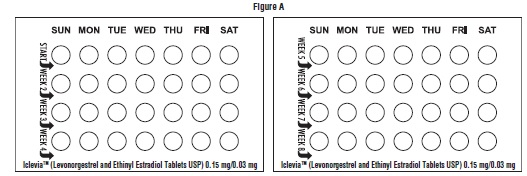
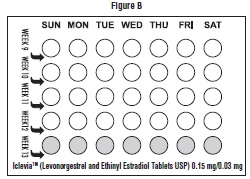
- Also find:
- Where on the first blister strip in the pack to start taking pills (upper left corner) and
- In what order to take the pills (follow the weeks)
- Be sure you have ready at all times another kind of birth control (such as condoms or spermicide), to use as a back-up in case you miss pills.
When should I start taking Iclevia?
If you start taking Iclevia and you have not used a hormonal birth control method before:
- Take the first white pill on the Sunday after your period starts, even if you are still bleeding. If your period begins on Sunday, start the first white pill that same day.
- Use another method of birth control (such as condoms or spermicides) as a back-up method if you have sex anytime from the Sunday you start your first white pill until the next Sunday (first 7 days).
If you have recently given birth and have not yet had a period, use another method of birth control if you have sex (such as condoms and spermicides) as a back-up method until you have taken Iclevia for 7 days.
If you start taking Iclevia and you are switching from another birth control pill:
- Start your new Iclevia pack on the same day that you would start the next pack of your previous birth control method.
- Do not continue taking the pills from your previous birth control pack.
If you start taking Iclevia and previously used a vaginal ring:
- Start using Iclevia on the day you would have reapplied the next ring.
If you start taking Iclevia and previously used a transdermal patch:
- Start using Iclevia on the day you would have started a new cycle (first patch application).
If you start taking Iclevia and you are switching from a progestin-only method such as an implant or injection:
- Start taking Iclevia on the day of removal of your implant, or on the day when you would have had your next injection.
If you start taking Iclevia and you are switching from an intrauterine device or system (IUD or IUS):
- Start taking Iclevia on the day of removal of your IUD or IUS.
- You do not need back-up contraception if your IUD or IUS is removed on the first day (Day 1) of your period. If your IUD or IUS is removed on any other day, use non-hormonal back-up contraception such as condoms or spermicide for the first 7 days that you take Iclevia.
Keep a calendar to track your period: If this is the first time you are taking birth control pills, read, “When should I start taking Iclevia?” above. Follow these instructions for a Sunday Start.
Instructions for using your Iclevia Extended-Cycle Wallet:
Sunday Start:
- Take pill 1 on the Sunday after your period starts. To remove your pill from the wallet, press the pill through the hole in the bottom of the wallet. See Figure C.
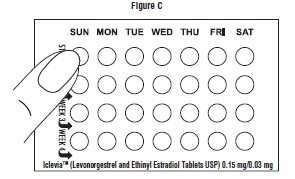
- If your period starts on a Sunday, take pill “1” that same day.
- Take 1 pill at about the same time every day until you have taken the last pill in the wallet.
- After taking the last green pill on Day 91 from the wallet, start taking the first white pill from a new Extended-Cycle Wallet on the very next day (this should be a Sunday). Take the first pill in the new pack whether or not you are having your period.
- Use non-hormonal back-up contraception such as condoms or spermicide for the first 7 days of the first cycle that you take Iclevia.
What should I do if I miss any Iclevia pills?
If you miss 1 white pill, follow these steps:
- Take it as soon as you remember. Take the next pill at your regular time. This means you may take 2 pills in 1 day.
- Then continue taking 1 pill every day until you finish the pack.
- You do not need to use a back-up birth control method if you have sex.
If you miss 2 white pills in a row, follow these steps:
- Take 2 pills on the day you remember and 2 pills the next day.
- Then continue to take 1 pill every day until you finish the pack.
- You could become pregnant if you have sex in the 7 days after you miss two pills. You must use a non-hormonal birth control method (such as a condom or spermicide) as a back-up if you have sex during the first 7 days after you restart your pills.
If you miss 3 or more white pills in a row, follow these steps:
- Do not take the missed pills. Keep taking 1 pill every day until you have completed all of the remaining pills in the pack. For example, if you start taking the pill on Thursday, take the pill under “Thursday” and do not take the missed pills. You may have bleeding during the week following the missed pills.
- You could become pregnant if you have sex during the days of missed pills or during the first 7 days after restarting your pills. You must use a non-hormonal birth control method (such as a condom or spermicide) as a back-up when you miss pills and for the first 7 days after you restart your pills. If you do not have your period when you are taking the green pills, call your healthcare provider because you may be pregnant.
If you miss any of the 7 green pills:
- Throw away the missed pills.
- Keep taking the scheduled pills until the pack is finished.
- You do not need a back-up method of birth control.
Finally, if you are still not sure what to do about the pills you have missed
- Use a back-up method anytime you have sex.
- Keep taking one pill each day until you contact your healthcare provider.
If you have any questions or are unsure about the information in this leaflet, call your healthcare provider.
This Patient Information and Instructions for Use have been approved by the U.S. Food and Drug Administration.
Distributed by:
Aurobindo Pharma USA, Inc.
279 Princeton-Hightstown Road
East Windsor, NJ 08520
Manufactured by:
Aurobindo Pharma Limited
Hyderabad-500 032, India
Revised: 04/2023
PACKAGE LABEL-PRINCIPAL DISPLAY PANEL - 0.15 mg/0.03 mg (91 Tablets Pouch Label)
NDC 65862-865-94
IcleviaTM
(Levonorgestrel and Ethinyl
Estradiol Tablets USP)
0.15 mg/0.03 mg
Rx only 1 Extended-Cycle Wallet,
Containing 91 Tablets
Contains 1 Extended-Cycle Wallet containing 91 tablets: Eighty-four white
tablets, each containing 0.15 mg levonorgestrel USP with 0.03 mg ethinyl
estradiol USP, and seven green inert tablets.
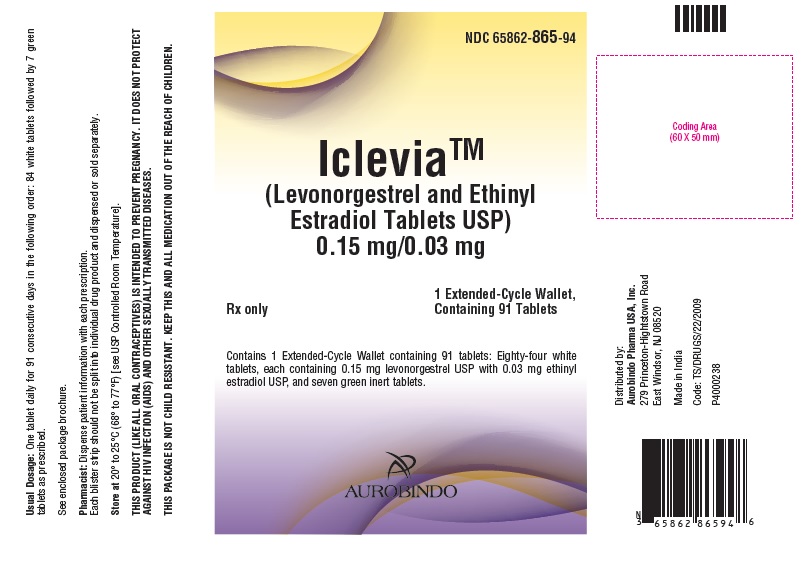
PACKAGE LABEL-PRINCIPAL DISPLAY PANEL - 0.15 mg/0.03 mg (91 Tablets Carton Pouch Label)
NDC 65862-865-94
IcleviaTM
(Levonorgestrel and Ethinyl
Estradiol Tablets USP)
0.15 mg/0.03 mg
Rx only 3 Extended-Cycle Wallets,
91 Tablets Each
THIS PRODUCT (LIKE ALL ORAL CONTRACEPTIVES) IS INTENDED TO PREVENT PREGNANCY. IT DOES NOT
PROTECT AGAINST HIV INFECTION (AIDS) AND OTHER SEXUALLY TRANSMITTED DISEASES.
Contains 3 Extended-Cycle Wallets, each containing 91 tablets: Eighty-four white
tablets, each containing 0.15 mg levonorgestrel USP with 0.03 mg ethinyl
estradiol USP, and seven green inert tablets.
